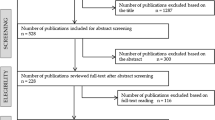Abstract
Recent studies have indicated positive effects of modified work for workers with musculosceletal complaints. The question remains how effectively modified work can be implemented in companies. This study describes barriers for introducing modified work for workers on sickness absence due to musculoskeletal complaints. Modified work was defined as gradually increasing the physical demands at work until the worker is ready for full duty in his regular job. In order to describe barriers in implementation of modified work, a model based on health education was used, consisting of six successive stages. A questionnaire derived from this model was sent to human resource managers of different companies and their occupational health physicians. The internal consistency was estimated with the Cronbach's alpha. The results showed a large number of barriers for modified work. According to 52% of the company management and 54% of the occupational health physicians evident barriers were found due to lack of knowledge on modified work and negative attitudes of the employees. Both companies and physicians reported a barrier in the possibilities to change the work tasks (45–54%) or the organization of the work (45–38%). About 62% of the companies reported barriers due to a mismatch between the education of the sick worker and the specific requirements of modified work. Despite the assumed positive effects of modified work, the implementation process is hampered by a large number of barriers. A maximum effort from all parties involved is required for a successful rehabilitation process.
Similar content being viewed by others
REFERENCES
Elders, LA, van der Beek, AJ, Burdorf, A. Return to work after sickness absence due to back disorders-a systematic review on intervention strategies. Int Arch Occup Environ Health 2000; 73(5): 339-348.
Weir, R, Nielson, WR. Interventions for disability management. Clin J Pain 2001; 17(Suppl 4): S128-S132.
Krause, N, Dasinger, LK, Neuhauser, F. Modified work and return to work: A review of literature. J Occup Rehabil 1998; 8(2): 113-139.
Koes, BW, van Tulder, MW, Ostelo, R, Kim Burton, A, Waddell, G. Clinical guidelines for the management of low back pain in primary care: An international comparison. Spine 2001; 26(22): 2504-2513; Discussion 2513-2514.
Malmivaara, A, Hakkinen, U, Aro, T, Heinrichs, ML, Koskenniemi, L, Kuosma, E, Lappi, S, Paloheimo, R, Servo, C, Vaaranen, V, Hernberg, S. The treatment of acute low back pain-Bed rest, exercises, or ordinary activity? N Engl J Med 1995; 332(6): 351-355.
van Tulder, MW, Koes, BW, Assendelft, WJ, Bouter, LM, Maljers, LD, Driessen, AP. Acute lage rugpijn: actief blijven, NSAID's en spierverslappers effectief, bedrust en specifieke oefeningen niet effectief; resultaten van systematische reviews 'Acute low back pain: Activity, NSAID's and muscle relaxants effective; bedrest and targeted exercise not effective; results of systematic reviews'. Ned Tijdschr Geneeskd 2000; 144(31): 1484-1489.
Hagen, KB, Hilde, G, Jamtvedt, G, Winnem, MF. The Cochrane review of bed rest for acute low back pain and sciatica. Spine 2000; 25(22): 2932-2939.
Improvement Ifcs. Health Care Guideline: Adult Low Back Pain. Bloomington, USA, 2001, Available at www.icsi.org
NVAB. Handelen van de bedrijfsarts bij werknemers met lage rugklachten. Richtlijnen voor Bedrijfsartsen, April 1999.
Urlings, IJ, Nijboer, ID, Dul, J. A method for changing the attitudes and behaviour of management and employees to stimulate the implementation of ergonomic interventions. Ergonomics 1990; 33(5): 629-637.
Loisel, P, Gosselin, L, Durand, P, Lemaire, J, Poitras, S, Abenhaim, L. Implementation of a participatory ergonomics program in the rehabilitation of workers suffering from subacute back pain. Appl Ergon 2001; 32(1): 53-60.
Dellve, L, Lagerstrom, M, Hagberg, M. Rehabilitation of home care workers: Supportive factors and obstacles prior to disability pension due to musculoskeletal disorders. J Occup Rehabil 2002; 12(2): 55-64.
Scheel, IB, Hagen, KB, Herrin, J, Oxman, AD. A randomized controlled trial of two strategies to implement active sick leave for patients with low back pain. Spine 2002; 27(6): 561-566.
Scheel, IB, Hagen, KB, Oxman, AD. Active sick leave for patients with back pain: All the players onside, but still no action. Spine 2002; 27(6): 654-659.
Grol, R. Beliefs and evidence in changing clinical practice (personal paper). BMJ 1997; 315(7105): 418-421.
Feder, G, Eccles, M, Grol, R, Griffiths, C, Grimshaw, J. Clinical guidelines: Using clinical guidelines. BMJ 1999; 318(7185): 728-730.
Kok, GJ, Meertens, RW, Wilke, HAM. Voorlichting en verandering. Groningen, The Netherlands: Wolters-Noordhoff, 1987.
Burdorf, A, Sorock, G. Positive and negative evidence of risk factors for back disorders. Scand J Work Environ Health 1997; 23(4): 243-256.
Pransky, G, Katz, JN, Benjamin, K, Himmelstein J. Improving the physician role in evaluating work ability and managing disability: A survey of primary care practitioners. Disabil Rehabil 2002; 24(16): 867-874.
Guzman, J, Yassi, A, Cooper, JE, Khokhar, J. Return to work after occupational injury. Family physicians' perspectives on soft-tissue injuries. Can Fam Physician 2002; 48: 1912-1919.
Anema, JR, Van Der Giezen, AM, Buijs, PC, Van Mechelen, W. Ineffective disability management by doctors is an obstacle for return-to-work: A cohort study on low back pain patients sicklisted for 3-4 months. Occup Environ Med 2002; 59(11): 729-733.
Nagamachi, M. Requisites and practices of participatory ergonomics. Int J Ind Ergon 1995; 15: 371-377.
Moore, JS, Garg, A. The effectiveness of a participatory ergonomics program in the red meat packing industry-Evaluation of a corporation. Int J Ind Ergon 1998; 21(1): 47-58.
Author information
Authors and Affiliations
Rights and permissions
About this article
Cite this article
van Duijn, M., Miedema, H., Elders, L. et al. Barriers for Early Return-to-Work of Workers with Musculoskeletal Disorders According to Occupational Health Physicians and Human Resource Managers. J Occup Rehabil 14, 31–41 (2004). https://doi.org/10.1023/B:JOOR.0000015009.00933.16
Issue Date:
DOI: https://doi.org/10.1023/B:JOOR.0000015009.00933.16




